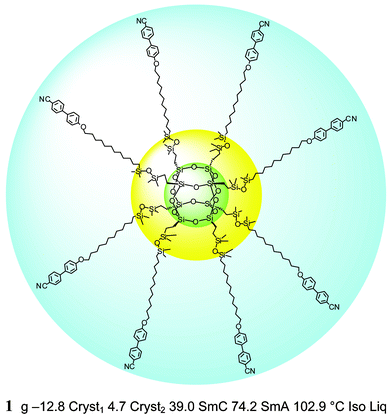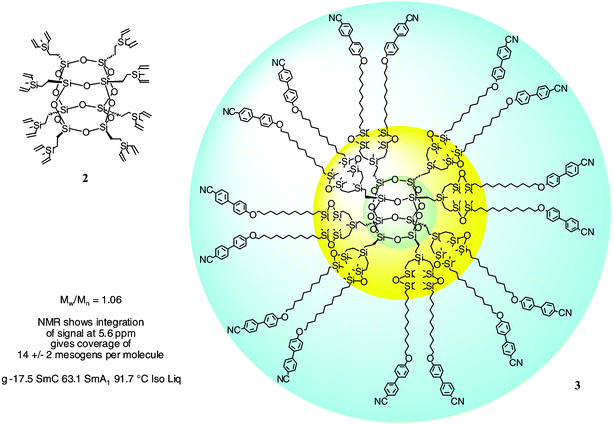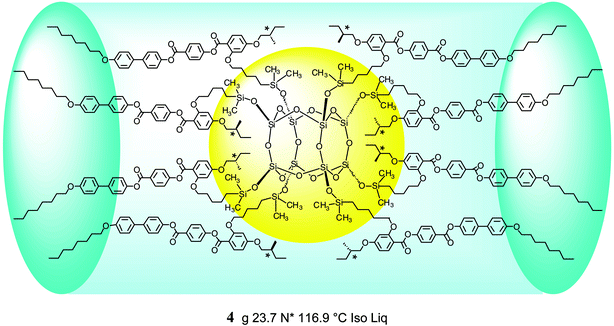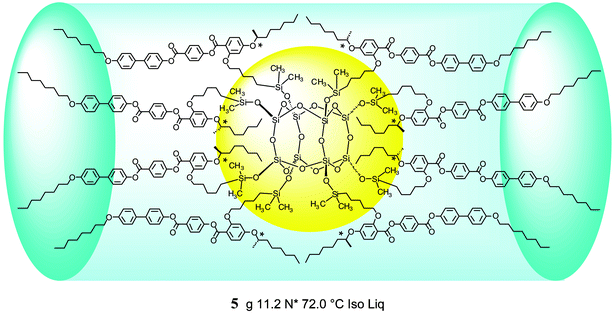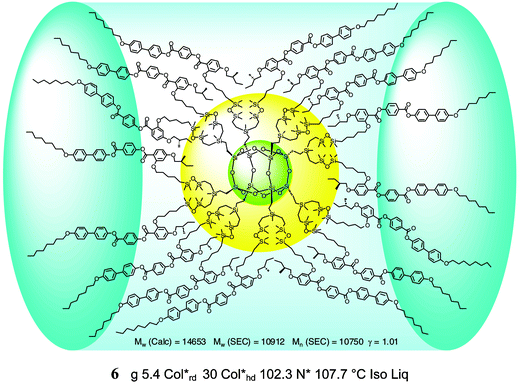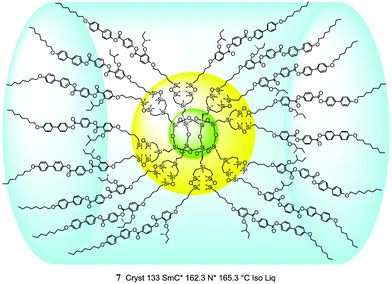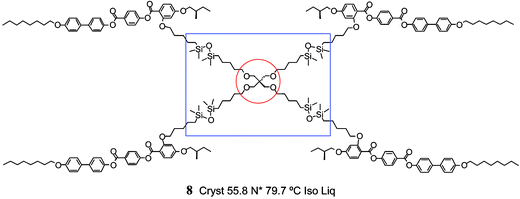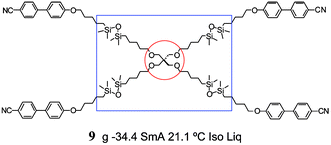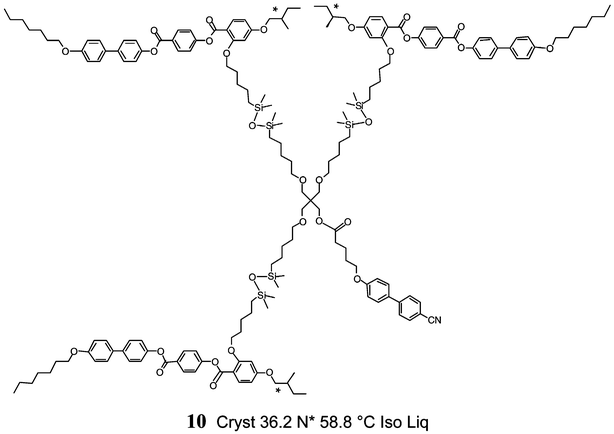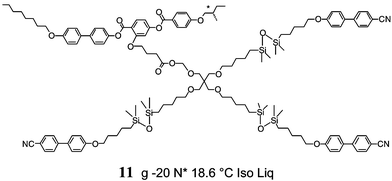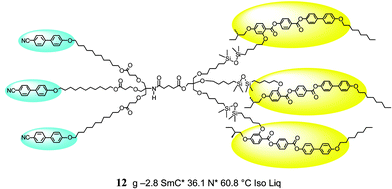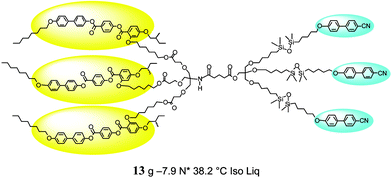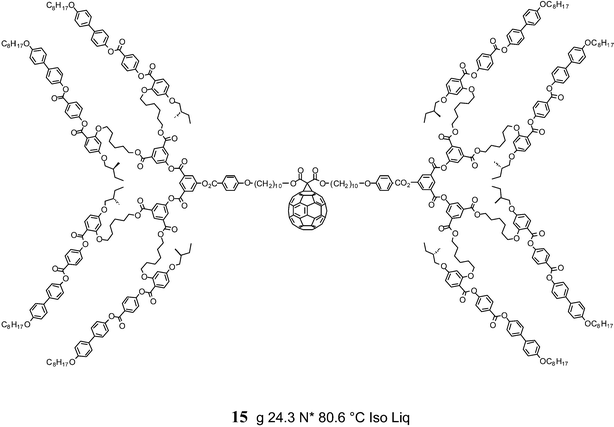Supermolecular liquid crystals
Isabel M.
Saez
and
John W.
Goodby
Liquid Crystals and Organic Materials Research Group, University of York, Heslington, York, UK YO10 5DD
First published on 29th November 2004
Abstract
In this article we review recent work on the development and study of the properties of self-organising supermolecular and supramolecular materials, that are in size comparable to small proteins. We take the concept of the creation of dendritic liquid crystals, and apply it to the creation of new materials with single identifiable entities, so that they are monodisperse or are single compounds. We show how functionality can be in-built into such materials so that self-organising functional systems can be created.
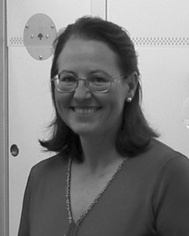 Isabel M. Saez | Dr Isabel M. Saez obtained her PhD in from the University of Alcalá de Henares, Madrid, and after working with Professor P. M. Maitlis in Sheffield and Dr W. A. Graham in Edmonton, Canada, on mechanistic organometallic chemistry, she joined the Liquid Crystal Group at the University of Hull in 1992, and was Leverhulme Research Fellow for four years. She now has a permanent appointment in Hull as a Senior University Research Fellow. Recently her work on liquid crystals with Janus-like microphase segregated molecular structures was highlighted in Chemical and Engineering News and the Annual Review of the American Chemical Society. |
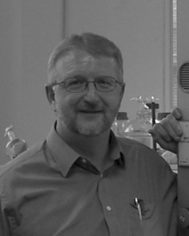 John W. Goodby | Professor John W. Goodby is currently Chairman of the British Liquid Crystal Society, and until recently was the President of the International Liquid Crystal Society. He studied for his PhD under the guidance of Professor G. W. Gray FRS CBE before moving to AT&T Bell Laboratories in the USA where he spent nine years as Supervisor of the Liquid Crystal Materials Group. In 1996 he was the first recipient of the G. W. Gray Medal of the British Liquid Crystal Society, in 1994 he was the Amersham Senior Research Fellow of the Royal Society, in 2002/3 he was the Tilden Lecturer of the Royal Society of Chemistry, and in 2002 he was awarded an Honorary Doctorate from Trinity College, Dublin. Currently, he is Professor of Materials Chemistry in the University of York. |
Introduction
The engines of living systems are based on supermolecular and supramolecular self-organising and self-assembling systems of discrete structure and topology, where supermolecular describes a giant molecule made up of covalently bound smaller identifiable components, and supramolecular means a system made up of multiple components that are not covalently bound together. For example, proteins, although peptide polymers, have defined and reproducible primary compositions of amino acids, specified α-helical and β-pleated secondary constructions, and gross topological tertiary structures. Moreover, highly specific functionality, and thereby the ability to perform selective chemical processing, is in-built into such molecular machines. Concomitantly, the study of materials that self-assemble into supramolecular structures with desirable functionality and physical properties at nano- and mesoscopic length scales is currently an exciting area of intense research, and provides a “bottom-up” approach to the design and synthesis of functional materials.1Until recently, most liquid crystals have been designed to be either low molar weight for displays or high molecular weight for prototypical high yield strength polymers.2 Supermolecular liquid crystals, on the other hand, combine the unique traits of the self-organisation of discrete low molecular weight materials with those of polymers in their ability to form secondary and tertiary structures. Furthermore, super- and supra-molecular liquid crystals3 exhibit a variety of physical properties which make them attractive for applications in the fields of nanoscience, materials and biology. They offer a very elegant and effective way of adding functionalisation together with an exquisite and unprecedented level of control of the precise nature and location of specific functionalities and overall molecular architectures, as in proteins. As a consequence, the initial interest in super- and supra-molecular liquid crystal synthesis has shifted towards functional dendrimers because of the latter's rich supramolecular chemistry and self-assembling properties.4 The very properties of precise control of functionality and molecular architecture are also essential ingredients in the molecular engineering of liquid crystals for controlling and fine-tuning the physical properties that ultimately define the self-organising process that leads to mesophase formation.2 Thus, super- and supra-molecular liquid crystals provide unique materials for the study of the structures and properties of self-organising and self-assembling processes.3,4
Defining the structures of supermolecules
In the fledgling field of super- and supra-molecular liquid crystals, many different terms have been introduced which describe some of the same structures. Fig. 1 shows some classical molecular architectures which can be used to describe the gross structures of super- and supramolecular liquid crystals. For example, two mesogenic units, ie molecular entities that favour mesophase formation, can be tied end to end to give linear supermolecular materials. If the mesogenic groups are the same they are called dimers, but if they are different they are referred to as bimesogens. The mesogenic units may also be tied together laterally, rather than end to end, or they may have terminal units tied to lateral units to give T-shaped dimers or bimesogens. With trimers the situation becomes more complicated because not only are there linearly and laterally linked possible structures, there are structures where the mesogenic units could be linked to a central point, creating a “molecular knot”. In a similar way, tetra-, penta-, etc substituted supermolecules can be created. Increased numbers of mesogenic units attached to a central point can be created by introducing a central scaffold upon which to build the supermolecular structures. Thus cyclic, caged or hyperbranched scaffolds can be utilised.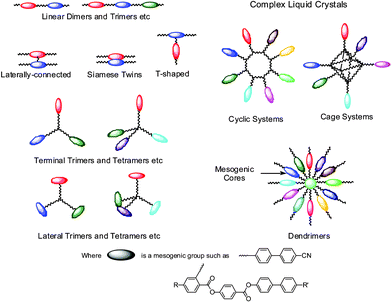 | ||
| Fig. 1 Templates for the design of liquid crystalline supermolecular materials. The mesogenic units are shown as ellipsoids of differing colours, however, the materials may be constructed with mesogenic units of the same type. | ||
Such supermolecular materials can be thought of as dendritic structures when the mesogenic units are all of the same type. Fig. 2 depicts the general structure of a dendrimer where repeating Y-shaped units are linked together one shell on top of another to create various generations of the dendrimer. Typically identical mesogenic units are located at the surface to the dendritic scaffold, thereby creating a dendritic liquid crystal, or a polypedal (an object having many feet which are the same) supermolecule. Alternatively, if the mesogenic units are mostly different with respect to one another, then the supermolecule will have many different feet, and thus could be termed a multipedal supermolecule. There is a clear distinction between these two types of supermolecular system; the polypedal supermolecule, like a polymer, can be subject to polydispersity, whereas the multipedal supermolecular material is not; it can be similar in constitution to a protein and have a primary structure. In fact Newkome et al. make the observation that “on the preparation of dendritic macromolecules, the continued inability to ascertain the absolute homogeneity of the resultant structures has led many to claim monodisperse character of their products”.5
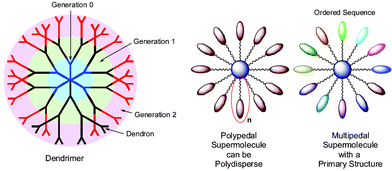 | ||
| Fig. 2 A dendritic scaffold, polypedal (many feet the same) supermolecule which can be subject to polydispersity, and a multipedal (many different feet) supermolecule which is not necessarily subject to polydispersity. | ||
There is of course a further distinction between a supermolecule and a supramolecular system. A supermolecule is a giant molecular entity that is made up of covalently bonded identifiable molecular units, thus it is similar in constitution to that of a tertiary structure of a protein. A supramolecular system, on the other hand, is a self-assembled, non-covalently bonded entity where complete molecular units are brought together through non-covalent forces to create a complex structure similar in constitution to that of a quaternary structure of a protein. Fig. 3 shows both of the supermolecular and supramolecular constructions. Thus, a supermolecule has a clearly defined chemical constitution, whereas for the supramolecular system it is possible to have variations in the constitution depending on how many molecular units are required to create the self-assembling, and hence self-organising, complex system.
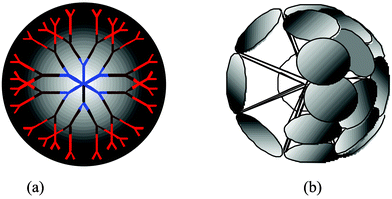 | ||
| Fig. 3 (a) The architecture of a supermolecule, and (b) the complex self-organised structure of a supramolecular entity. | ||
Through the incorporation of chemically or physically active moieties into the structures of super- and supra-molecular systems, “functional” or “smart” self-organising materials can be created. Such material systems are related to proteins in that they can be designed to have specific structures and properties. For example, Fig. 4 shows a template for a supermolecular system where two functional units A and B are incorporated into its structure. A and B may interact with each other or with other chemical entities introduced to the supermolecular system. The design of such “smart” functional supermolecular materials is expected to have a strong impact on the future development of materials science, as this area of research offers a powerful alternative for managing the awkward gap in the length scale which exists between top-down miniaturisation and bottom-up nanofabrication.
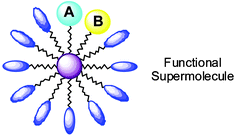 | ||
| Fig. 4 Template structure of a smart or functional supermolecular material. | ||
The self-organisation processes
The way in which supermolecules can self-organise is dependent to a large degree on simple structural features, such as the density of the mesogenic units attached to the periphery of the central scaffold, their orientation of attachment, and the degree to which they are decoupled from the scaffold. For example, the density of mesogenic groups attached to the periphery can effectively change the overall gross shape of the structure of the supermolecule from being rod-like, to disc-like to spherulitic. Thus, the structure of the systems at a molecular level can be considered as being deformable, where each type of molecular shape will support different types of self-organised mesophase structure. Thus, for supermolecular materials, rod-like systems will support the formation of calamitic mesophases (including the various possibilities of smectic polymorphism), disc-like systems tend to support columnar mesophases, and spherulitic systems form cubic phases, as shown in Fig. 5.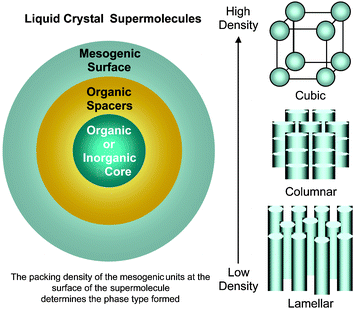 | ||
| Fig. 5 Effect of the number density of mesogens on the surface of the supermolecular structure on the formation of various mesophases. | ||
Similar structure-self-organising properties are also found for supramolecular systems, and indeed in some cases far more complex polymorphism and a richer variety of mesophase types are found.6
Although there have not been extensive research studies into the effects that the type (rod-like, disc-like or spherulitic) of mesogenic group attached to the central scaffold has on mesophase formation, it is clear for rod-like shaped mesogenic groups that the orientation of the attachment can markedly influence the type of mesophase formed and polymorphism of any smectic phases formed. As with side chain liquid crystal polymers (SCLCPs), lateral attachment (side-on) of the mesogenic units often leads to supermolecular systems exhibiting nematic phases, whereas for terminal attachment (end-on) smectic phases appear to predominate, as shown in Fig. 6.
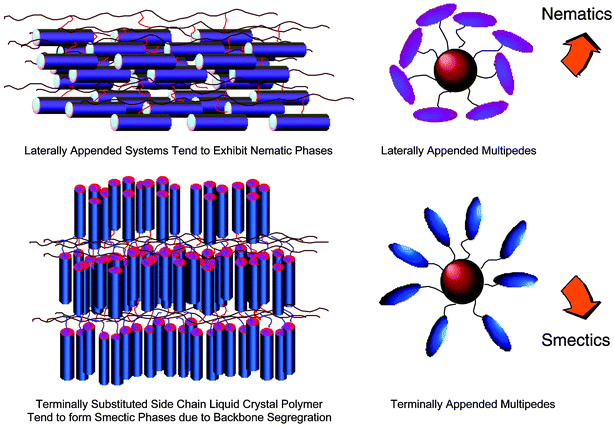 | ||
| Fig. 6 Orientation of attachment of rod-like mesogenic groups to a central scaffold and mesophases formed for supermolecular systems, shown in comparison to the structures of side chain liquid crystal polymers. | ||
In addition to number density and orientation of attachment, the degree to which the mesogenic units are decoupled from the central structure is important. The shorter the linking unit, the more likely the material will act as single supermolecular entity, whereas the longer the spacer the more likely it is that the properties of the individual mesogenic groups will dominate the overall properties of the material.
Apart from these coarse property–structure activity relationships, a secondary level of structure needs to be considered in defining the finer points of such relationships. For example, the central scaffolds might be considered to be soft (flexible) or hard (rigid), there might be blocks of mesogenic groups of one type or another, there could be microphase segregating units incorporated into the periphery or the scaffold of the material, mesogenic units might be incorporated into the scaffold as well as the periphery, it is also possible to incorporate metallomesogenic units as well as conventional organic mesogenic moieties, and chirality might be introduced into any part of the structure. Fig. 7 shows some examples of templates for supermolecular materials bearing blocks of mesogenic units, some of which are functionalised. The variety of templates available is thus very large, indicating the potential for the development of novel materials with designer properties.
 | ||
| Fig. 7 Templates for supermolecular materials bearing A–B blocks of mesogenic units, some of which are functionalised. | ||
Through self-assembly and self-organisation processes, liquid crystalline phases have opened up new perspectives in materials science towards the design and engineering of supramolecular materials.1a,d,e The self-organisation in two- and three-dimensional space offered by the liquid crystalline medium is an ideal vehicle to explore and control the organisation of matter on the nanometre to the micrometre scale which are key to the emerging development of nanotechnology.
In the following sections we describe the structures of novel polypedal, multipedal and functional supermolecular materials.
Liquid crystalline polypedes (dendrimers)
As noted above, various morphologies have been documented for dendritic and hyperbranched liquid crystal polymers, and this topic has recently received intense interest.4 Although the exhaustive revision of this area is outside the scope of this article, several types can be easily identified: a) hyperbranched polymers and liquid crystal dendrimers in which the mesogenic groups form part of each branching unit; b) dendrimers without mesogenic groups that form liquid crystal phases, where the formation of the mesophases is due to self-assembly process of the constituents dendrons, aided by microphase segregation, and c) liquid crystal dendrimers formed by attachment of liquid crystal moieties to the periphery of a suitable core dendrimer, where the mesogenic units are located on the surface of the dendritic core.The first thermotropic liquid crystalline dendrimer, I, was reported by Percec and Kawasumi for a hyperbranched polyether structure that consisted of an AB2 monomer, with a mesogenic unit based on conformational isomerism. Different end-groups were used to terminate the polymer, and the gauche conformation was found to favour the dendritic geometry in the solid state; however the anti conformation was obtained at higher temperatures and this was found to stabilise the formation of the nematic phase.7
Lattermann et al reported the first metallomesogenic dendrimer when they described results on trigonal bipyramidal metal complexes of ethyleneimine dendrimers of the first and second generation, based on derivatives of tris(2-aminoethyl)amine. Complexes of cobalt, nickel, copper and zinc were prepared and found to exhibit relatively low temperature mesophases, which generally possessed hexagonal columnar structures. These materials therefore provided the first examples of metallomesogenic dendrimers.8
The groups of Shivaev and Frey reported simultaneously the first examples of materials that are classed as conventional liquid crystal dendrimers. In these reports they described the synthesis of liquid crystalline carbosilane dendrimers, which differ from the above dendritic liquid crystals in that the mesogenic groups are located only at the surface.9 Thus the materials combine a flexible, dendritic carbosilane inner core which is functionalised on the surface with cyanobiphenyl groups or cholesteryl groups, attached by flexible spacers via either classical hydrosilylation reactions or through esterifications; see Fig. 8 for example. This material has 36 mesogenic moieties attached to its periphery, however, the flexibility of the central scaffold allows the supermolecule to deform its shape to give a rod-like overall form, thereby supporting the formation of calamitic mesophases. Remarkably, although the individual mesogenic groups would normally support the formation of nematic phases at temperatures above room temperature, the supermolecule exhibits a wider temperature range for the mesomorphic state (SmA), with a glassy phase being formed well below room temperature. In this series of materials up to 124 mesogens have been attached to the periphery, and at higher number densities of mesogens, i.e. for higher generations of the dendritic scaffold, columnar phases start to appear. However, the introduction of columnar phases at higher generations is indicative of the flexibility of the scaffold which allows for a wide variety of conformers to be present in the lower generations that support the formation of rod-like gross shapes of the supermolecule.9
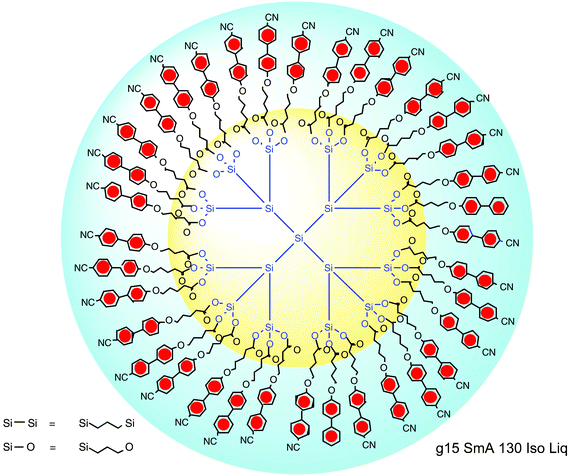 | ||
| Fig. 8 Example of a typical liquid crystal dendrimer with its mesogenic units covalently attached to the outer surface of a flexible scaffold.9 | ||
Within the now conventional group of liquid crystal dendrimers, we have reported a group of liquid crystalline dendrimers based on the octasilsesquioxane core, which provides eight primary (radial) branches for derivatisation, allowing an increased packing of the mesogens around the dendritic core at earlier generations; moreover, the rigid framework of the octasilsesquioxane core offers the possibility of a contrasting comparison with dendrimers derived from entirely flexible scaffolds, among others PPI, PAMAM, carbosiloxanes and esters.10
The first example we discuss, supermolecule 1, is an octamer based the octasilsesquioxane core unit.11 This material was prepared and purified in such a way that by HPLC and 29Si NMR spectroscopy it was shown to be a single compound without dispersity. Unlike the materials described above, this material exhibits smectic polymorphism with SmC and SmA phases being formed. The incorporation of cyanobiphenyl mesogenic moieties means that the material has interesting dielectric properties, and the presence of the smectic C phase indicates that with the introduction of chirality the material would also be ferroelectric and pyroelectric. The mesophase sequence of g −12.8 Cryst1 4.7 Cryst2 39.0 SmC 74.2 SmA 102.9 °C Iso Liq, demonstrates that the dendritic structure of the supermolecule is constrained to being rod-like, and that the rod-like conformers tilt over at the smectic A to smectic C phase transition, as shown in Fig. 9. Thus, the structures of both the smectic A and the smectic C phases have alternating organic and inorganic and layers. As the inorganic and organic layers have differing refractive indices, the mesophase structures are essentially nano-structured birefringent slabs.
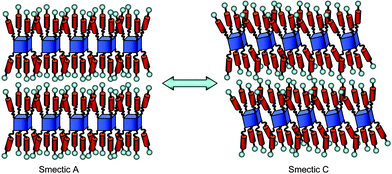 | ||
| Fig. 9 The structures and phase transition for the smectic A and smectic C phases of multipede 1, where the spheres represent the terminal cyano moieties. | ||
The number of mesogenic groups can be increased in the periphery by the hydrosilylation of the first generation hexadecavinyl octasilsesquioxane dendimer 2 with cyanobiphenyl mesogens containing terminal Si–H groups, thereby affording the liquid crystal multipede 3, which contains sixteen cyanobiphenyl groups attached to the dendritic core.11 For this material the 1H NMR spectrum showed well resolved resonances for all the protons of the cyanobiphenyl mesogenic groups, indicating complete conformational freedom of the mesogenic units in solution. Complementary 29Si NMR spectroscopy shows that the reaction of the cyanobiphenyl mesogens with the vinyl units of 3 was incomplete, and although the distribution was much sharper than normally found for polymers, nevertheless the material shows a degree of dispersity and is not a unique compound. The molecular weight of 3 was under-estimated by SEC, an effect frequently encountered in dendrimers, which has been interpreted as evidence of a globular conformation in solution.
Multipede 3 shows a phase sequence of g −17.5 SmC 63.1 SmA 91.7 °C Iso Liq. Thus the effective doubling of the number of mesogenic units has the effect of lowering the clearing point, the SmC to SmA transition and the glass transition relative to 1. This thermal behaviour is in contrast with that normally found for liquid crystal dendrimers based on flexible dendritic cores, where the clearing points increase and the glass transitions remain almost constant with generation number.10
The mesophase behaviour of 3 implies that the dendrimer must, like supermolecule 1, have a rod-like shape in order that it can pack in layers, where the molecules within the layers are disordered and the layer structure is diffuse, revealing that the mesogenic state deforms the globular environment of the dendrimer. This is remarkable given that the number of mesogenic units is doubled relative to the number of octasilsesquioxane scaffolds, see Fig. 10, and where as a consequence one would expect curvature in the packing of the mesogenic units to occur due to their bunching about the scaffolds.
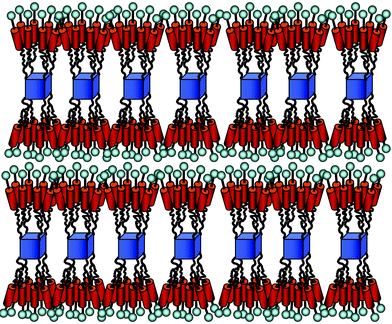 | ||
| Fig. 10 Schematic drawing of the bilayer structure of the smectic A phase of multipede 3. The 16 mesogenic units (red cylinders and spheres which represent the cyano groups) per molecule are accommodated in the layers without the introduction of curvature in the packing of the mesogenic units together. | ||
As noted earlier, in general, as for traditional side-chain liquid crystal polymers, the end-on attachment of the mesogenic moieties affords smectic phases, whereas side-on mesogenic sub-units lead to nematic phases. By appending laterally attached chiral mesogenic units to the octasilsesquioxane scaffold we targeted the induction of the chiral nematic phase into this class of materials. Supermolecule 4, the size of a small globular protein (i.e. MW = 6560), was prepared as a single material with a dispersity of 1, and as predicted it exhibited a chiral nematic phase with a helical macrostructure. The material exhibits an extraordinarily long temperature range for the chiral nematic phase. A transition from a glassy state to the chiral nematic phase occurs near to room temperature and then the phase extends over ninety degrees before transforming to the isotropic liquid at 116.9 °C.12
The local structure of the chiral nematic phase is shown in Fig. 11 where the supermolecules are shown as having rod-like/tubular structures where the mesogenic units are expected to intermingle between the supermolecules. The chiral nematic phase will have a helical macrostructure superimposed upon the local nematic ordering as shown in the figure. Remarkably the material has a helical pitch of approximately 2 µm, which is a relatively short pitch considering the size of the polypede, and approximately the same as the pitch that which would be produced by the individual mesogenic units without spacers being attached. However, unlike for the mesogenic units, the pitch is relatively temperature insensitive. Thus the surface of the polypede acts as a molecular recognition surface, in a similar way to recognition surfaces are created in surfactant systems and Janus grains as described by de Gennes.13
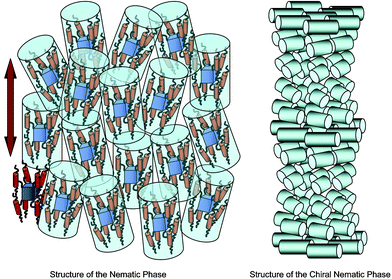 | ||
| Fig. 11 Schematic representation of the local nematic structure and the helical structure of the chiral nematic phase of dendrimer 4. | ||
By changing the chiral moiety associated with the liquid crystal units, the physical properties of the supermolecular system can be changed and/or fine-tuned. For example, changing the chiral group from 2-methylbutyl to 2-octyl, as for polypede 5 (MW = 6889) in comparison to 4, the glass to chiral nematic phase transition is lowered to a value below room temperature, and similarly the clearing point is substantially reduced. However, the chiral nematic phase still exists over a temperature range of approximately 60 °C, which is quite remarkable considering that the low molar mass equivalents melt above 70 °C, thus supermolecular systems provide access to liquid crystal phases over much wider temperature ranges than the low molar mass equivalents.12
The pitch of the helix for compound 5 was found to be approximately 0.2–0.3 µm, thus the material selectively reflects visible light over a wide temperature range. Moreover the pitch is relatively temperature insensitive thus the material can be used in large area non-absorbing polarizers, or in optical notch filters or reflectors. In addition, in the glassy state the helical macrostructure of the chiral nematic phases is retained, thus similar applications are possible.
As with the terminally appended systems, it was possible to bifurcate the scaffold so that twice the number of mesogenic units could be bound to the central scaffold. Thus, the first generation octasilsesquioxane dendrimer 6, which is the size of a small protein (MW = 14653) possessing sixteen side-on attached mesogenic units, was prepared. After purification, the material was found to be monodisperse by MALDI-TOF spectrometry, size exclusion chromatography and 29Si NMR spectroscopy; see Fig. 12 for the NMR spectrum.
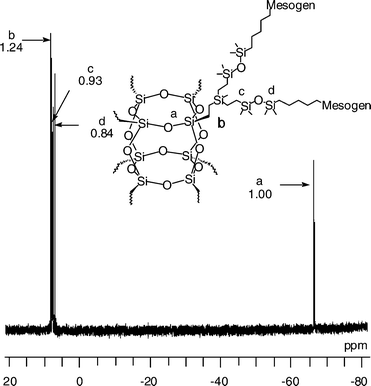 | ||
| Fig. 12 The 29Si NMR spectrum of supermolecule 6 showing the resonances for four identifiable silicon atoms. | ||
Compound 6 was found to exhibit chiral nematic phase (see the texture in Fig. 13), hexagonal disordered columnar (see Fig. 14) and rectangular disordered columnar phases, in the sequence g 5.4 Col*rd 30 Col*hd 102.3 N* 107.7 °C Iso Liq.14 Thus the increase in the number density of the mesogens bound to the central scaffold transforms the situation from the octamers 4 and 5, which exhibit calamitic phases, to one where the hexadecamer 6 exhibits columnar phases. However, the formation of columnar phases when the dendrimer possesses rod-like mesogenic groups is not easy to visualise unless the mesogenic groups surround the octasilsesquioxane core to give a cotton-reel-like structure. From the point of view of the mesophase structure, the best fit to the X-ray data was obtained using such a “cotton-reel” model, which suggests that in the hexagonal columnar phase the dendrimer assumes a cylindrical shape that has approximately the same height as its diameter. The long axes of the mesogenic units are roughly parallel to or slightly tilted with respect to the rotational axis that is normal to the cylinder, ie they are nematic-like, and they are packed together side by side on the outer surface of the cylinder, in a disordered fashion, as shown in Fig. 15.
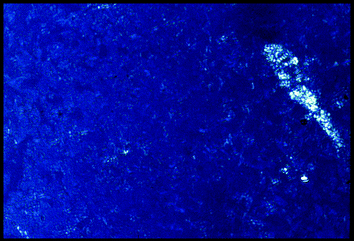 | ||
| Fig. 13 The Grandjean plane texture of the chiral nematic phase of supermolecule 6. The blue iridescent colour is due to the selective reflection of light from the helical macrostructure (×100). | ||
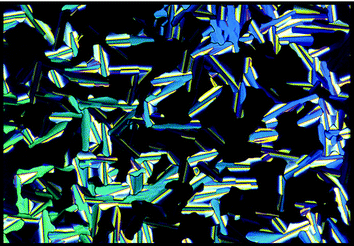 | ||
| Fig. 14 The homeotropic and rectilinear defect textures of the hexagonal columnar phase of supermolecule 6 (×100). | ||
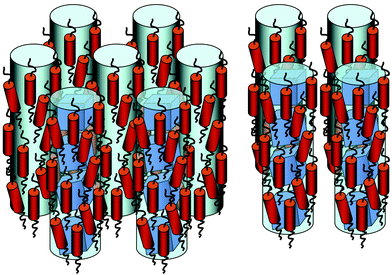 | ||
| Fig. 15 Schematic structures of the hexagonal tubular nematic (left) and rectangular tubular nematic (right) phases. The mesogenic groups are roughly parallel to the columns but their positions are disordered. Thus the columns effectively act as the directors of the nematic phase. | ||
The mesogenic behaviour of 6 emphasizes the role played by the octasilsesquioxane core when compared with the related side-chain liquid crystalline polysiloxanes.15 It is remarkable that the thermal stability of the chiral nematic phase is similar in both the polymer and the dendrimer, suggesting that the cubic core does not perturb significantly the associations between the mesogens, which are necessary to support the chiral nematic phase.
Similarly, the formation of the columnar phases in the dendrimer 6, but not in the side-chain polysiloxanes, indicates that the silsesquioxane core assists in the interaction of neighbouring units resulting in the formation of the hexagonal and rectangular disordered structures, presumably through segregation of the siloxane cores from the mesogenic units in distinct columns. These remarkable new mesophase structures, which are essentially variations of “tubular nematic–columnar phases”, are favoured by the spacer length used to attach the mesogen to the dendrimer core, since it has been kept relatively short (five methylene units) in order to prevent full decoupling of the mesogenic motions from the silsesquioxane core and by forcing the mesogens to pack closely together around the dendritic core. The structures of the “hexagonal tubular nematic–columnar” and “rectangular tubular nematic–columnar” phases are shown schematically together in Fig. 15.
The hybrid structures of such “tubular nematic–columnar liquid crystal phases” lend themselves as potential model systems for the development of photonic band-gap materials, where large difference in refractive indices between the inorganic and organic sections can be engineered into the system through design and synthesis. In addition, the chiral nematic phase of the hexadecamer shows the selective reflection of blue light indicating that the pitch of the chiral nematic phase is sub-micron, approximately 0.2 to 0.3 µm.
By swapping the position of chiral group of the mesogen with the linking group to the central scaffold, polypede 7 is created where the mesogens are attached end-on. As predicted, the material does not exhibit columnar phases, but instead reverts to calamitic phases, with chiral nematic and chiral smectic C* phases being found. In terms of material properties the nematic phase of the supermolecule possesses a helical macrostructure and therefore reflects light. The chiral smectic C* phase is ferroelectric as was shown by electrical field studies, however the polarization was not determined because of the slowness of the response of the material.
Liquid crystalline multipedes and giant molecules
Multipedes are essentially a step away from polymer and dendritic systems towards the complex super- and supra-molecular materials found in living organisms, where materials with selective functional properties are incorporated into self-assembling and/or self-organising states of matter. If we consider firstly the two polypedes 8 and 9, tetramer 8 has four laterally appended chiral mesogenic groups and therefore exhibits a chiral nematic phase as expected. Similarly, tetramer 9, which has terminally appended mesogenic groups, exhibits a smectic phase as expected.Replacement of one of the mesogenic groups in either of the tetramers by a mesogenic group from the other tetramer results in two new supermolecules 10 and 11.16 These materials are no longer dendrimers but are molecules in their own right with discrete structures. The introduction of a terminally appended mesogen into a supermolecule which has predominantly laterally appended mesogens in the periphery, as for 10, results in a lowering of the relative melting point, but the mesomorphic properties remain nematic, which is expected as the terminally appended mesogen serves to increase the disordering in the system.
However, when a laterally appended mesogen is introduced into a system where all of the other mesogens are terminally appended, as for 11, the laterally appended mesogen acts as a disrupter to the orderly packing of the molecules together. This results in the suppression of the formation of smectic modifications and support for nematic phases. Thus compound 9, which is smectic A, is converted into a chiral nematic phase as in 11. A comparison of the nematic structures of 10 and 11 is shown in Fig. 16.
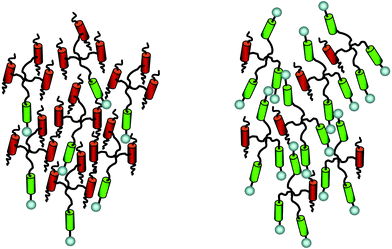 | ||
| Fig. 16 Schematic representation of the nematic phases formed by multipedes 10 and 11 which have mixed lateral and terminal mesogenic groups. | ||
Interestingly, material 11 has a nematic phase at room temperature, with a glassification point at −20 °C. In comparison 4-pentyl-4′-cyanobiphenyl has a melting point of 24 °C and a clearing point of 34 °C. Furthermore, mechanical shearing of specimens of the nematogenic materials 10 and 11 show that the samples have low viscosity, indicating that they have rheological properties similar to those of low molar mass mesogens.
Fine tuning of material properties therefore can be achieved by using mixtures of mesogens attached to the periphery of the scaffold. In addition, the disordering induced can substantially lower melting points and widen temperature ranges of desirable liquid crystal phases. Furthermore, such materials are miscible with low molar mass materials, and can be used to modify their physical properties.
Janus liquid crystals
One of the more intriguing and challenging aspects in materials science is understanding the molecular recognition and self-assembling processes in materials with diversely functionalised faces or sides, which can yield supramolecular objects that may recognise and select left from right, or top from bottom, as described by de Gennes.13 For example, Janus grains,17a block co-polymers in the form of Janus micelles,17b segregated amphiphilic dendrimers,17c–e shape-persistent macromolecules17f and polar colloidal particles17g are abiotic examples of such materials that self-organise, like proteins, in a pre-programmed fashion.We have described a new concept for the design of self-assembling functional liquid crystals18 as “Janus” liquid crystalline molecular materials in the form of segmented structures that contain two different types of mesogenic units, which can favour different types of mesophase structure, grafted onto the same scaffold, to create giant molecules that contain different hemispheres (“Janus” refers to materials with two faces, such as fluorocarbon/hydrocarbon or hydrophilic/hydrophobic, etc, for example a Janus supermolecule with hydroxyl and hydrocarbon faces has been recently reported19). Thus, we studied the complementary materials 12 and 13, based on a central scaffold made up of pentaerythritol and tris(hydroxymethyl)aminomethane units linked together, where one unit carries three cyanobiphenyl (CB) (smectic preferring) and the other three chiral phenyl benzoate (PB) (chiral nematic preferring) mesogenic moieties or vice versa,20 see Fig. 17.
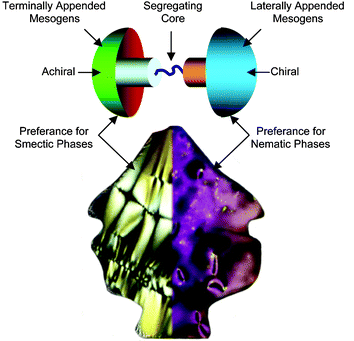 | ||
| Fig. 17 Conceptual design of Janus liquid crystalline supermolecular systems, where the Janus head is composed of a nematic liquid crystal (right) and a smectic liquid crystal (left). | ||
Both Janus compounds, 12 and 13, were isolated as single compounds in a glassy state at room temperature. The MALDI-TOF mass spectra of 13 are shown in Fig. 18. The predicted isotopic distribution is shown together with the experimental isotopic distribution for the mass ion. The two distributions overlay each other identically confirming the purity of the material and demonstrating the utility of MALDI-TOF in the determination of structure in supermolecular systems.
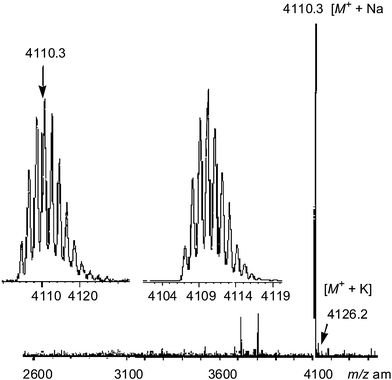 | ||
| Fig. 18 MALDI-TOF spectra for compound 13; (a) the full spectral details, (b) the predicted isotopic distribution for the mass ion, and (c) measured isotopic distribution. | ||
On heating 12, a broad melting endotherm with onset at 33.8 °C (ΔH = 6.26 kJ mol−1) was followed by a transition from the liquid crystal state to the liquid at 60.8 °C (ΔH = 2.73 kJ mol−1). The cooling cycle from the isotropic liquid showed a broad, weak exotherm, onset at 60.3 °C, marking the transition to the chiral nematic phase. A second exotherm occurred on cooling, onset 36.1 °C, marking a second order transition to a chiral smectic C* phase. Further cooling induced a glass transition at approximately −2.8 °C. This sequence of events was reproducible in subsequent heating and cooling cycles. It is noteworthy that the transitions have extremely low ΔH/ΔS values, suggesting that the system is relatively disordered and highly flexible. In addition, it is important to note that the formation of chiral mesophases by compound 12 means that the nematic phase is thermochromic and the smectic C* phase is ferroelectric and pyroelectric and will exhibit electrostrictive properties.
In contrast, compound 13 exhibits only one enantiotropic transition by DSC which occurs between a chiral nematic phase and the isotropic liquid, in the form of a weak and broad peak at 38.2 °C (ΔH = 0.87 kJ mol−1). The only other thermal event present was a glass transition below room temperature at −7.9 °C. Only when the sample was left standing at room temperature for three weeks did a broad, strong endotherm with onset at 31.6 °C with a shoulder at 42.6 °C occur. However, these thermal events were not present in successive heating and cooling cycles, suggesting that crystallisation only occurs on standing after a long period of time.
Comparison of the phase behaviour of compounds 12 and 13 shows clearly that the overall topology of the molecule in respect to the inner core (i.e. which hemisphere carries what mesogen) plays a significant role in determining the type of mesophase formed, since in both cases the number of mesogens of each type and the core are the same, and simply by placing them in different hemispheres the mesophase exhibited is changed.
The manipulation of the structural fragments (mesogenic units, central scaffold, and linking units) in the molecular design of such supermolecular systems potentially allows us to vary mesophase type and therefore the physical properties and potential applications of materials. Thus the molecular design of these systems is flexible and potentially capable of incorporating functional units, thereby allowing us to take some steps towards the molecular and functional complexity found in living systems.
Functional liquid crystalline supermolecules
The concept of creating functional materials by incorporating a certain functionality within a liquid crystalline molecule, through covalent attachment, is a bottom-up approach to self-organising functional materials. In collaboration with R. Deschenaux (University of Neuchâtel, Switzerland), in the following examples we incorporated fullerene as the functional unit into self-organising supermolecular systems. Fullerene was selected because of its interesting physical properties and in order to see if such a large non-mesogenic unit would affect mesomorphic properties. Thus, the synthesis of fullerene-containing liquid crystals was expected to open new avenues in the design of self-organised structures containing the fullerene unit.21 This approach to self-organisation appears to be particularly interesting for other functional groups which are not well adapted to being organised in nanoscale architectures.The three-dimensional structural analogy between fullerene and the octasilsesquioxane was exploited designing chiral nematic fullerene dendrimers.22 These were synthesized by the Bingel reaction of fullerene and dendritic malonates of several generations, carrying chiral nematic mesogens attached in a side-on fashion. Fullerene dendrimer 14 shows an enantiotropic chiral nematic phase, with a phase sequence of g 26 N* 69 °C Iso Liq. The values of the pitch of the helix of the chiral nematic phase obtained indicate that C60 fits within the helical structure formed by the mesogens themselves without causing any significant perturbation of the pitch. This, in turn, implies that although the large C60 unit disturbs the mesogenic interactions, therefore lowering the clearing point, it can be effectively camouflaged within the self-organising chiral nematic medium, provided that enough mesogenic sub-units are available in the dendritic addend, without markedly suppressing the liquid crystalline state.
Indeed when the number density of the mesogenic is increased, thereby reducing the weight fraction of fullerene units in the supermolecular structure, see 15, the liquid crystal phases become increasingly more stable and the spherical fullerene unit becomes increasingly hidden within the liquid crystal matrix.22b This result indicates that the liquid crystal units have the ability to incorporate and organise non-mesogenic functional units into the self-organising state, without too much detriment to the liquid crystal itself.
Thus, we can apparently control the periodic ordering of non-mesogenic functional units through the process of self-organisation. Similar approaches recently have been taken by Sakai and Matile23 and Zhuravel et al,24 but in both of these cases, amino acids were used to induce self-assembly, and ultimately self-organisation.
Conclusions
In this brief review, we have demonstrated the potential for creating a wide variety of novel supermolecular and supramolecular materials with designer structural and functional properties. In our development of new materials we have borne in mind the philosophy and approach used by living systems in the creation of monodisperse and discrete supermolecular materials with specific functionality. In particular, the design features employed in the creation of proteins have been used in the creation of materials which do not bear any common atomistic relationship with proteins themselves. In this way, this new field lies open for the development of materials for which their design is only limited by human imagination.Acknowledgements
The authors are very grateful to The Leverhulme Trust for financial support.References
- (a) J.-M. Lehn, Supramolecular Chemistry: Concepts and Perspectives, VCH, Weinheim, 1995 Search PubMed; (b) J.-M. Lehn, Science, 2002, 295, 2400 CrossRef CAS; (c) G. M. Whitesides and B. Grzybowski, Science, 2002, 295, 2418 CrossRef CAS; (d) T. Kato, Science, 2002, 295, 2414 CrossRef CAS; (e) J. E. Elemans, A. E. Rowan and R. J. M. Nolte, J. Mater. Chem., 2003, 13, 2661 RSC.
- See for example Handbook of Liquid Crystals ed. D. Demus, J.W. Goodby, G.W. Gray, H.-W. Spiess and V. Vill, Wiley-VCH, Weinheim, vols. 1–3, 1998 Search PubMed.
- (a) T. J. Bunning and F. H. Kreuzer, Trends Polym.Sci., 1995, 3, 318 Search PubMed; (b) J. W. Goodby, G. H. Mehl, I. M. Saez, R. P. Tuffin, G. Mackenzie, R. Auzely-Velty, T. Benvegnu and D. Plusquellec, Chem. Commun., 1998, 2057 RSC; (c) C. Tschierske, J. Mater. Chem., 1998, 8, 1485 RSC; (d) J. W. Goodby, Curr. Opin. Solid State Mater. Sci., 1999, 4, 361 CrossRef CAS; (e) C. Tschierske, J. Mater. Chem., 2001, 11, 2647 RSC; (f) C. Tschierske, Curr. Opin. Colloid Interface Sci., 2002, 7, 69 Search PubMed; (g) J. W. Goodby, Curr. Opin. Colloid Interface Sci., 2002, 7, 326 Search PubMed; (h) V. Percec, T. K. Bera, M. Glodde, Q. Fu, V. S. Balagurusamy and P. A. Heiney, Chem. Eur. J., 2003, 9, 921 CrossRef CAS , and references therein.
- For selected examples of liquid crystalline and functional dendrimers see: (a) S. A. Ponomarenko, N. I. Boiko and V. Shibaev, Polym. Sci. Ser. C, 2001, 43, 1 Search PubMed; (b) V. Percec, M. Glodde, T. K. Bera, Y. Miura, I. Shiyanovskaya, K. D. Singer, V. S. K. Balagurusamy, P. A. Heiney, I. Schnell, A. Rapp, H.-W. Spiess, S. D. Hudson and H. Duank, Nature, 2002, 419, 384 CrossRef; (c) D. A. Tomalia, Nat. Mater., 2003, 2, 711 CrossRef CAS; (d) G. R. Newkome, C. N. Moorefield and F. Vögtle, in Dendrimers and Dendrons. Concepts, Syntheses, Applications, Wiley-VCH, Weinheim, 2000 Search PubMed; (e) Dendrimers and Other Denritic Polymers, ed. J.-M. Fréchet and D. A. Tomalia, Wiley, Chichester, 2001 Search PubMed; (f) J.-M. Fréchet, J. Polym. Sci. Part A: Polym. Chem., 2003, 41, 3713 CrossRef CAS; (g) S. M. Grayson and J.-M. Fréchet, Chem. Rev., 2001, 101, 3819 CrossRef CAS; (h) D. C. Tully and J.-M. Fréchet, Chem. Commun., 2001, 1229 RSC; (i) V. Percec and M. Holerca, Biomacromolecules, 2000, 1, 6 CrossRef CAS; (j) A. Syamakumari, A. P. H. J. Schenning and E. W. Meijer, Chem. Eur. J., 2002, 8, 3353 CrossRef CAS; (k) F. S. Precup-Blaga, A. P. H. J. Schenning and E. W. Meijer, Macromolecules, 2002, 36, 565 CrossRef; (l) L. Gehringer, D. Guillon and B. Donnio, Macromolecules, 2003, 36, 5593 CrossRef CAS.
- G. R. Newkome, C. D. Weiss, C. N. Moorfield and I. Weiss, Macromolecules, 1997, 30, 2300 CrossRef.
- (a) V. Percec, W. D. Cho, G. Ungar and D. J. P. Yardley, J. Am. Chem. Soc., 2001, 123, 1302 CrossRef CAS; (b) X. B. Zeng, G. Ungar, Y. S. Lin, V. Percec, S. E. Dulcey and J. K. Hobbs, Nature, 2004, 428, 157 CAS; (c) V. Percec, C. M. Mitchell, W. D. Cho, S. Uchida, M. Glodde, G. Ungar, X. B. Zeng, Y.S. Liu, V. S. K. Valagurusamy and P. A. Heiney, J. Am. Chem. Soc., 2004, 126, 6078 CrossRef CAS.
- V. Percec and M. Kawasumi, Macromolecules, 1992, 25, 3843 CrossRef CAS.
- (a) U. Stebani and G. Latterman, Adv. Mat., 1995, 7, 578 CrossRef CAS; (b) U. Stebani, G. Lattermann, M. Wittenberg and J. Wendorf, Angew. Chem. Int. Ed. Engl., 1996, 35, 1858 CrossRef CAS.
- (a) S. A. Ponomarenko, E. A. Rebrov, A. Y. Bobrovsky, N. I. Boiko, A. M. Muzafarov and V. P. Shivaev, Liq. Cryst., 1996, 21, 1 CrossRef CAS; (b) K. Lorenz, D. Hölter, B. Stühn, R. Mülhaupt and H. Frey, Adv. Mater., 1996, 8, 414 CAS.
- See for example (a) M. W. P. L. Baars, S. Söntjens, H. M. Fischer, H. W. I. Peerlings and E. W. Meijer, Chem. Eur. J., 1998, 4, 2456 CrossRef CAS; (b) S. A. Ponomarenko, N. I. Boiko, V. P. Shibaev, R. M. Richardson, I. J. Whitehouse, E. A. Rebrov and A. M. Muzafarov, Macromolecules, 2000, 33, 5549 CrossRef CAS; (c) B. Donnio, J. Barberá, R. Jiménez, D. Guillon, M. Marcos and J. L. Serrano, Macromolecules, 2002, 35, 370 CrossRef CAS; (d) J. M. Rueff, J. Barberá, B. Donnio, D. Guillon, M. Marcos and J. L. Serrano, Macromolecules, 2003, 36, 8368 CrossRef CAS; (e) U. W. Gedde, A. Hult and G. Andersson, Macromolecules, 2001, 34, 1221 CrossRef CAS.
- I. M. Saez and J. W. Goodby, Liq. Cryst., 1999, 26, 1101 CrossRef CAS.
- I. M. Saez and J. W. Goodby, J. Mater. Chem., 2001, 11, 2845 RSC.
- P.-G. de Gennes, Angew. Chem. Int. Ed. Engl., 1992, 31, 842 CrossRef , Nobel Lecture.
- I. M. Saez, J. W. Goodby and R. M. Richardson, Chem. Eur. J., 2001, 7, 2758 CrossRef CAS.
- (a) R. A. Lewthwaite, G. W. Gray and K. J. Toyne, J. Mater. Chem., 1992, 2, 119 RSC; (b) R. A. Lewthwaite, G. W. Gray and K. J. Toyne, J. Mater. Chem., 1993, 3, 241 RSC.
- I. M. Saez and J. W. Goodby, J. Mater. Chem., 2003, 13, 2727 RSC.
- (a) C. Cassagrande and M. Veyssié, C. R. Acad. Sci. Paris, Ser. II, 1988, 306, 1423 Search PubMed; (b) R. Erhardt, M. Zhang, A. Böker, H. Zettl, C. Abetz, P. Frederik, G. Krausch, V. Abetz and A. H. E. Müller, J. Am. Chem. Soc., 2003, 125, 3260 CrossRef CAS; (c) C. J. Hawker, K. L. Wooley and J.-M. Fréchet, J. Chem. Soc. Perkin Trans. 1, 1993, 1287 RSC; (d) S. M. Grayson and J.-M. Fréchet, J. Am. Chem. Soc., 2000, 122, 10335 CrossRef CAS; (e) D. Pesak and J. S. Moore, Tetrahedron, 1997, 53, 15331 CrossRef; (f) D. Zhao and J. S. Moore, Chem. Commun., 2003, 807 RSC; (g) O. Cayre, V. N. Paunov and O. D. Velev, J. Mater. Chem., 2003, 13, 2445 RSC.
- (a) I. M. Saez and J. W. Goodby, Chem. Commun., 2003, 1726 RSC; (b) See for example C&E News, 2003, July 14, p 10 Search PubMed.
- J. Ropponen, S. Nummelin and K. Rissanen, Org. Lett., 2004, 6, 2495 CrossRef CAS.
- I. M. Saez and J. W. Goodby, Chem. Eur. J., 2003, 9, 4869 CrossRef CAS.
- (a) M. Even, B. Heinrich, D. Guillon, D. M. Guldi, M. Prato and R. Deschenaux, Chem. Eur. J., 2001, 7, 2595 CrossRef CAS; (b) T. Chuard and R. Deschenaux, J. Mater. Chem., 2002, 12, 1944 RSC; (c) S. Campidelli, R. Deschenaux, J. F. Eckert, D. Guillon and J.-F. Nierengarten, Chem. Commun., 2002, 656 RSC; (d) M. Sawamura, K. Kawai, Y. Matsuo, K. Kanie, T. Kato and E. Nakamura, Nature, 2002, 419, 702 CrossRef CAS.
- (a) S. Campidelli, C. Eng, I. M. Saez, J. W. Goodby and R. Deschenaux, Chem. Commun., 2003, 1520 RSC; (b) S. Campidelli, C. Eng, R. Deschenaux, I. M. Saez and J. W. Goodby, 19th International Liquid Crystal Conference, Edinburgh, 2002, poster 789 Search PubMed.
- N. Sakai and S. Matile, Chem. Commun., 2003, 2514 RSC.
- M. A. Zhuravel, N. E. Davis, S. T. Nguyen and I. Koltover, J. Am. Chem. Soc., 2004, 126, 9882 CrossRef CAS.
| This journal is © The Royal Society of Chemistry 2005 |


